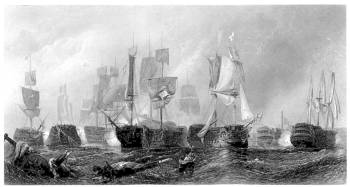The Minotaur at the battle of Trafalgar
An hour before the battle, Captain Mansfield mustered the ships company and spoke to them as follows:
Men, we are now in the sight of the enemy whom there
is every probability of engaging; and I trust that this day, or tomorrow, will
prove the most glorious our country ever saw. I shall say nothing to you of
courage: our country never produced a coward. For my own part I pledge myself
to the officers and ship’s company not to quit the ship I may get alongside of
till either she strikes or sinks – or I sink. I have only to recommend silence
and strict attention to the orders of your officers. Be careful to take good
aim, for it is to no purpose to throw shot away. You will now, every man,
repair to your respective stations, and depend, I will bring the ship into
action as soon as possible.
God save the King!
 Captain Mansfield kept his pledge, and not by sinking. By the end of the day the Minotaur
had played a pivotal role in defending the Victory against the counter attack
by Rear Admiral Dumanoir's squadron, and had captured the Spanish Neptuno.
Captain Mansfield kept his pledge, and not by sinking. By the end of the day the Minotaur
had played a pivotal role in defending the Victory against the counter attack
by Rear Admiral Dumanoir's squadron, and had captured the Spanish Neptuno.
The Minotaur and the Spartiate were the last two ships in Nelson's weather column, with the Spartiate behind the Minotaur. Nelson's plan for the battle was to attack the combined French and Spanish fleets with two columns initially approaching the enemy line at right angles, the weather column led by Nelson in the Victory, and the lee column led by Collingwood in the Royal Sovereign.
After a squally night, the British fleet was scattered over a wide area as dawn broke and the enemy fleet was sighted. The wind died, and ships found it difficult to get into position. The two British columns became very strung out and the Minotaur and Spartiate did not sail fast in light winds. Nelson did not wait for the slower ships to keep up because his battle plan relied on speed and surprise.
The British were outnumbered by the combined enemy fleet 27 to 33, and Nelson's plan was for Collingwood's lee column to overwhelm the rear of the combined fleet while his weather column cut the French and Spanish vanguard out of the battle and took on the centre. Because of the light winds, it would take them a long time for the van to turn round and rejoin the battle. The plan was to engage the enemy in close action where the superior gunnery and training of the British seamen would gain an advantage.
After Nelson cut the enemy line in the Victory, the French and Spanish van of 8 ships with Rear Admiral Dumanoir in the Formidable continued to sail northwards away from the battle, and it was about an hour before they started to turn round. Because of the light winds, this was a very slow manoeuvre and some of the ships had to launch boats to tow their bows round. Meanwhile, the Minotaur and Spartiate were slowly approaching the centre of the action where the Victory, Temeraire and other ships of the weather column were closely engaged.
Once the French and Spanish van had turned and were approaching the battle, they were joined by two more French ships and the counter attack from the force of ten ships posed a serious threat, particularly to the now badly damaged Victory. The battle was nearly won, but a concerted counter attack could have tipped the balance the other way. The Minotaur and the Spartiate hauled closer to the wind to intercept, and the enemy ships divided into two groups with Dumanoir in the Formidable leading the Duguay-Trouin, Mont-Blanc and Scipion to the west of the main battle in an attempt to cut off the Minotaur and Spartiate, while the others sailed towards the main battle area to be taken on by a newly formed British line.
Being upwind, the Minotaur and Spartiate could easily have avoided Dumanoir's greater force, but with no thought of that, they put themselves between the Victory and the French, and turned northwards in order to engage closely each of the four French ships in turn as they sailed by. Meanwhile the Spanish 80-gun Neptuno, having been deterred from following the other group by fire from the British line, was now following Dumanoir's ships a little way behind. The Minotaur and Spartiate were able to cut off the Neptuno, and tacking around her, engaged her on both sides. The Neptuno put up a stiff resistance, but having been dismasted, with Captain Valdes unconscious, and with 30 dead and 47 wounded, she finally surrendered to the Minotaur at dusk. The Minotaur suffered 3 dead and 20 wounded.
After Trafalgar, the Neptuno's ensign and the Minotaur's Union Jack were presented to Selling church in Kent by Stephen Hilton, master's mate of the Minotaur. They remained on display at Selling for nearly 200 years, and recently were on display at Deal Maritime and Local History Museum. We are waiting to hear news of future plans for the flags.
Captain's Log of the Minotaur at Trafalgar
The Minotaur's Officers and Crew at Trafalgar
About this site:
All content and images are copyright (C) 2005 Tony Beales, Gill Carter and/or original copyright holders. Copying of content or images is not allowed without permission.
